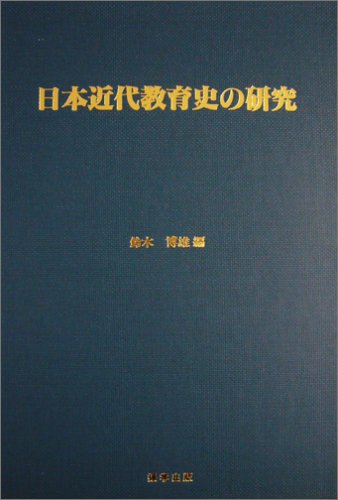3 0 0 0 IR 近世私塾の史的考察 : 元禄-享保期の私塾を中心として
- 著者
- 鈴木 博雄
- 出版者
- 横浜国立大学
- 雑誌
- 横浜国立大学教育紀要 (ISSN:05135656)
- 巻号頁・発行日
- vol.1, pp.1-34, 1962-03-30
This thesis tried to inquire the social background of the private schools in the feudal age from a historical stand of view. In middle age of Japan, there were few higher schools because of a internal war continued through the middle age. After the war, in the begininng of Tokugawa era, some private schools were appeared as a center of the movement for cultural and educational enlightenment. The typical schools in these private schools were Matunaga Sekigo's school which was established in 1637, Yamazaki Ansai's school which was established in 1655, Nakae Toju's school which was established in 1635 and Kinoshita Junan's school which was established in 1645. These typical school were founded in or near Kyoto which is a center of culture in the feudal age. In these school, Chinese Confucianism were taught as a moral teachings for not only warrior class but merchant and peasantry. In the middle of Tokugawa era, Ito Jinsai's school and Ogiu Sorai's school were most famous private schools. The former were established in Kyoto (1662) chiefly for merchant and peasantry. The latter were established in Tokyo (1709) chiefly for warrior class. They had a critical thought against Chu, Hsi (1130-1200)'s moral teachings which was most popular educational thought at that time. They improved educational methods, for example, Kaidoku-group reading methods-were used by both school at first. Teaching methods for the pronunciation of Chinese also improved by Ogiu Sorai's school.
3 0 0 0 OA 近世藩学における文武課業法の成立について
- 著者
- 鈴木 博雄
- 出版者
- 一般社団法人 日本教育学会
- 雑誌
- 教育学研究 (ISSN:03873161)
- 巻号頁・発行日
- vol.38, no.4, pp.273-281, 1971-12-30 (Released:2009-01-13)
- 参考文献数
- 31
2 0 0 0 OA 寛政期の学政改革と臣僚養成
- 著者
- 鈴木 博雄
- 出版者
- 横浜国立大学
- 雑誌
- 横浜国立大学教育紀要 (ISSN:05135656)
- 巻号頁・発行日
- vol.3, pp.23-51, 1963-11-15
In the above thesis the author has investigated the methods by which samurai were educated in the feudal period, with especial reference to educational reform in the Kansei era (1787~1798), a time when the education carried out by 'Hanko', clan conducted schools, was playing an important role in making samurai into feudalistic bureaucrats. In the feudal period, the samurai, whose job was mainly that of a soldier, came to become gradually more involved in the duties of official administration due mainly to the fact the country was in a state of peace and his servies as a fighter were unnecessary. In the beginning of the feudal period the structure of the government was very simple but as it and it's accompanying feudal bureaucracy became more complicated so there acrose the need for samurai able to read and write rather than fight. In order to meet this need the 'Hanko' were developed. In the first chapter the author inquired into the political ideas of Matsudaira Sada-nobu, the man in charge of political reform. The purpose of his reform lay in the training of feudal bureaucrats. His image of them was essentially feudal in that he required them to be persons of great integrity especially obedient to their feudal lord. on the other hand, like modern bureaucrats, they had to be skilled in administration. In the second chapter the author comments on the rules and plans of studies which were part of the reform, such as 'Gakumon Ginmi', (Intellectual examinations in the upper classes) and 'Sodoku Ginmi', (Intellectual examinations in the lower classes), and the construction of government schools. In the last chapter the author discusses how the contradiction of feudal and modern ideas caused the failure of overall education as far as feudal bureaucrats were concerned and the educational reforms which were actually put into practice.
1 0 0 0 日本近代教育史の研究
1 0 0 0 OA 文部官僚中川元文書
- 著者
- 鈴木 博雄 掛本 勲夫 坂本 保富 蛭田 道春 麻生 千明
- 出版者
- 教育史学会
- 雑誌
- 日本の教育史学 : 教育史学会紀要 (ISSN:03868982)
- 巻号頁・発行日
- vol.20, pp.106-123, 1977-10-05
1 0 0 0 近世私塾の史的考察--元文~天明期の私塾を中心として
- 著者
- 鈴木 博雄
- 出版者
- 横浜国立大学教育学部
- 雑誌
- 横浜国立大学教育紀要 (ISSN:05135656)
- 巻号頁・発行日
- no.2, pp.29-55, 1962-12
1 0 0 0 近世私塾の史的考察 : 元文-天明期の私塾を中心として
- 著者
- 鈴木 博雄
- 出版者
- 横浜国立大学
- 雑誌
- 横浜国立大学教育紀要 (ISSN:05135656)
- 巻号頁・発行日
- vol.2, pp.29-55, 1962-12



